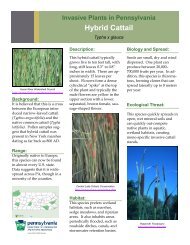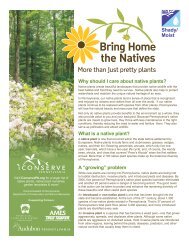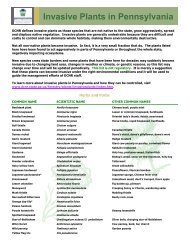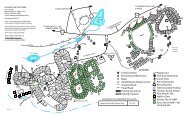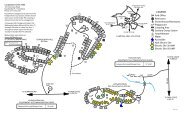You also want an ePaper? Increase the reach of your titles
YUMPU automatically turns print PDFs into web optimized ePapers that Google loves.
Background:<br />
Also know as <strong>Siebold</strong>’s<br />
arrowwood, this native of<br />
Japan was brought to the U.S.<br />
as an ornamental landscape<br />
plant. Many cultivars are still<br />
sold in the nursery trade.<br />
Range:<br />
eCommons@Cornell,<br />
http://hdl.handle.net/1813/1140<br />
The range of this species in the<br />
U.S. is not yet widespread. It<br />
can be found in scattered<br />
portions of the Mid-Atlantic<br />
(including Pennsylvania) and<br />
New England, as well as Ohio<br />
and Kentucky.<br />
Invasive Plants in Pennsylvania<br />
Description:<br />
<strong>Siebold</strong> Viburnum<br />
Viburnum sieboldii<br />
This large shrub or small tree<br />
can grow up to 20 feet tall and<br />
about half as wide. The<br />
simple, two to five-inch long<br />
deciduous leaves are arranged<br />
alternately along the branches.<br />
Photo: Richard Webb, www.invasive.org<br />
Leaves are dark green with<br />
serrated leaf margins. When<br />
crushed, they emit a foul odor.<br />
Abundant off-white flowers<br />
bloom in May. They can be up<br />
to six inches across and cover<br />
the whole plant. Small oval<br />
fruits change from red to black<br />
in color in September.<br />
Habitat:<br />
This plant grows easily and<br />
can adapt to various soil types,<br />
although it prefers moist, welldrained<br />
soil. It will grow in<br />
full sun to partial shade.<br />
Biology and Spread:<br />
Fruits grow in abundance<br />
along the length of the<br />
branches. Birds do love to eat<br />
the fruits, so they are a major<br />
vector for the spread of this<br />
species’ seeds.<br />
Ecological Threat:<br />
Little is known about the exact<br />
impacts this species has on the<br />
environment but it is assumed<br />
to have the ability to take over<br />
forest edges and disturbed<br />
areas, replacing native shrubs<br />
and understory trees. The U.S.<br />
Forest Service ranks it of “local<br />
concern”, worth monitoring<br />
for invasive tendencies.<br />
eCommons@Cornell,<br />
http://hdl.handle.net/1813/1140
How to Control this<br />
Species:<br />
Little research has<br />
specifically been aimed at<br />
controlling this species.<br />
However, the Brooklyn<br />
Botanic Garden suggests<br />
hand-pulling plants that are<br />
less than three feet tall.<br />
Taller shrubs should be cut at<br />
ground level prior to fruiting,<br />
then apply a 20 percent<br />
solution of glyphosate<br />
herbicide to avoid<br />
re-sprouting.<br />
References:<br />
Look-A-Likes:<br />
Invasive Exotic Plant Pest Tutorial for Land Managers:<br />
http://www.dcnr.state.pa.us/forestry/invasivetutorial/<br />
<strong>viburnum</strong>.htm<br />
University of Connecticut Plant Database:<br />
http://www.hort.uconn.edu/plants/v/vibpli/vibpli1.html<br />
Center for Invasive Species and Ecosystem Health:<br />
http://www.invasive.org<br />
Red chokecherry (Photinia<br />
pyrifolia) (top image) and<br />
possumhaw (Viburnum nudum<br />
L.) (bottom image) are native<br />
shrubs that could be confused<br />
with small <strong>Siebold</strong> <strong>viburnum</strong>s.<br />
Photo: Dow Gardens Archive,<br />
www.forestryimages.org<br />
Photo: James Miller & Ted Bodner,<br />
Southern Weed Science Society,<br />
www.forestryimages.org<br />
Native Alternatives:<br />
There are a variety of native<br />
shrubs with attractive flowers,<br />
fall foliage and fruit for<br />
wildlife, including:<br />
Common winterberry<br />
(Ilex verticillata)<br />
Photo: Dow Gardens Archive,<br />
www.forestryimages.org<br />
American beautyberry<br />
(Callicarpa Americana)<br />
Photo: John Byrd, Mississippi State U.,<br />
www.forestryimages.org<br />
Mapleleaf Viburnum<br />
(Viburnum acerifolium)<br />
Photo: Elmer Verhasselt,<br />
www.forestryimages.org








